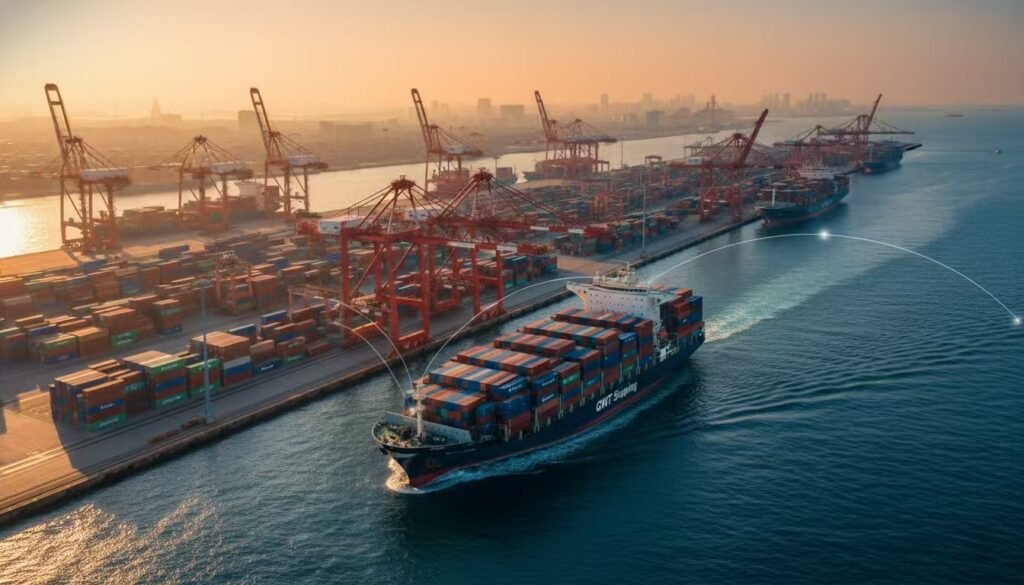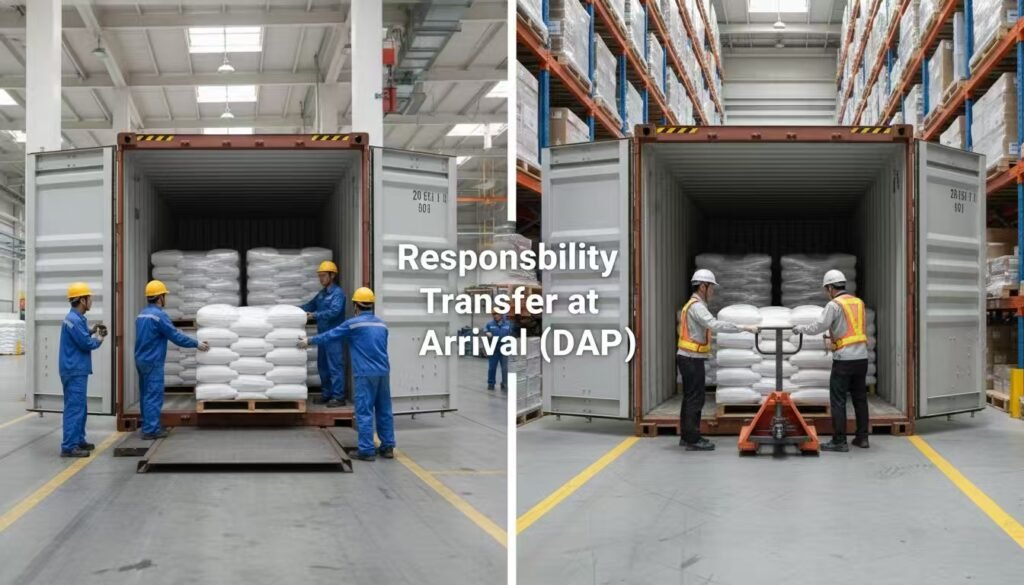2025 Definitive Guide: What is DAP?
By Guanwutong / November 12, 2025
An importer receives a quote from a supplier in Shenzhen: “DAP Tokyo.”
On the surface, the price is competitive. However, a critical question remains: What does this actually mean for the final landed cost? When that container arrives at the warehouse in Japan, who is responsible for the complex Japanese customs clearance, the import duties, and the significant 10% Japanese Consumption Tax?
This is a common, and often costly, misunderstanding in the DAP Incoterms for the China-to-Japan trade lane.
Many importers, and even some forwarders, may treat DAP (Delivered at Place) as a simple alternative to DDP. Our analysis indicates this can be a significant financial miscalculation. For imports into Japan, the difference between these two terms can mean an unexpected six-figure-yen (or more) bill, delayed cargo, and supply chain friction. The Incoterms 2020 rules, which replaced the old DAT with DPU, have also introduced new considerations for unloading responsibility.
This article is not a generic definition. It is a practical, expert-led guide for 2025, based on our direct experience managing daily FCL and LCL freight from China’s key ports to Japan’s major hubs.
We will deeply analyze the #1 challenge of DAP imports to Japan: mastering the responsibilities and costs associated with Japanese customs and consumption tax.

1. What is DAP? The Official Incoterms 2020 Definition
First, let’s establish the official definition from the International Chamber of Commerce (ICC) Incoterms 2020 rules.
DAP stands for “Delivered at Place.”
The core concept is that the seller is responsible for all costs and risks associated with delivering the goods to the buyer’s named destination (e.g., “DAP Tokyo Warehouse, 1-2-3 Chiyoda-ku”).
The seller arranges and pays for everything until the goods arrive at that final destination, still loaded on the arriving transport (usually a truck).
However, the single most critical exclusion in the DAP definition is this:
The seller is NOT responsible for import customs clearance or paying any import duties and taxes in the destination country.
Under DAP Incoterms, this responsibility falls 100% on the buyer. This is the central point of analysis for any import shipment from China to Japan.
2. Buyer vs. Seller Responsibilities: A Clear Breakdown for DAP Imports
When “DAP Tokyo” is stipulated in a contract, the responsibilities are clearly divided. It is essential to understand both sides (DAP buyer responsibility vs. DAP seller responsibility) to grasp the true DAP meaning.
Seller’s Responsibility
The seller’s obligation is to deliver the goods from their point of origin in China to the buyer’s named location in Japan. Their responsibilities include:
Export Packaging: Ensuring goods are packed for international ocean transit.
Export Clearance: Managing all customs formalities, declarations, and fees in China (e.g., at the Port of Shanghai or Shekou).
Main Carriage: Contracting and paying for the ocean freight from the port in China to the port in Japan.
On-Carriage in Japan: Paying for all terminal handling charges (THC) at the Japanese port and the subsequent inland trucking to the buyer’s named destination.
Proof of Delivery: Providing the buyer with the necessary transport documents to take possession.
Risk: The seller bears all risk of loss or damage until the goods arrive at the named destination, ready for unloading.
Buyer’s Responsibility
Once the truck arrives at the named destination, the responsibility—and risk—transfers to the buyer. The buyer’s responsibilities are fewer in number but are significantly more complex and costly.
Import Customs Clearance: The buyer must act as the Importer of Record (IOR) in Japan. They are responsible for all paperwork and communication with Japanese customs.
Customs Duties: The buyer must pay all applicable Japanese import tariffs based on the product’s HS code.
Taxes (Japanese Consumption Tax): The buyer must pay the 10% Japanese Consumption Tax (JCT). This is a substantial cost that is never included in the seller’s DAP price.
Unloading: The buyer is responsible for the act and risk of unloading the goods from the truck. Any damage during unloading is the buyer’s liability.
For any questions, feel free to contact GWT Shipping. Our team will provide professional, standards-compliant advice tailored to your specific needs.
3. The Critical Comparison: DAP vs. DDP vs. DPU for Shipments to Japan
This comparison is where most confusion—and financial risk—originates. Importers and procurement managers are constantly seeking to understand the difference between these “D” terms.
This simple comparison table clarifies the obligations under Incoterms 2020.
| Feature | DAP (Delivered at Place) | บริการ DDP (จัดส่งพร้อมชำระภาษีปลายทาง) | DPU (Delivered at Place Unloaded) |
| Main Freight | Seller Pays | Seller Pays | Seller Pays |
| Inland Transport (Japan) | Seller Pays | Seller Pays | Seller Pays |
| Import Clearance | Buyer | Seller | Buyer |
| Import Duties & Tax | Buyer | Seller | Buyer |
| Unloading Risk & Cost | Buyer | Buyer | Seller |

DAP vs. DDP (DAP vs DDP difference): The Tax & Customs Analysis
This is the most financially significant comparison for importers.
DAP: The Buyer acts as the Importer of Record. The Buyer pays all Japanese duties and the 10% JCT.
DDP: The Seller acts as the Importer of Record. The Seller pays all Japanese duties and the 10% JCT.
On the surface, DDP may seem simpler. However, as our deep dive will show, DDP is often more expensive, removes cost control from the buyer, and creates significant compliance challenges for the Chinese seller.
DAP vs. DPU (DAP vs DPU difference): The Unloading Responsibility
This is a key clarification in the Incoterms 2020 rules. DPU (Delivered at Place Unloaded) is the only Incoterm that requires the seller to unload the cargo.
DAP: The seller’s truck arrives. The buyer is responsible for providing the team and equipment (e.g., forklift) to unload. The risk of unloading rests with the buyer.
DPU: The seller is responsible for providing the team and equipment to unload the cargo. The risk of unloading rests with the seller.
DPU replaced the older DAT (Delivered at Terminal). This change was made because “terminal” was too restrictive. DPU can now be used for any destination, just like DAP—with the sole difference being the responsibility for unloading.
4. The Deep Dive: Why DAP is the “Japan Challenge” (DAP customs duties & consumption tax)
We now arrive at the core of our 2025 analysis. A “DAP” shipment to many countries is straightforward. However, DAP from China to Japan involves a unique set of compliance and tax challenges that can severely impact an importer’s budget if not managed proactively.
The 10% Problem: Japanese Consumption Tax
When importing goods into Japan, the Japanese Consumption Tax (JCT) of 10% is levied. This tax is calculated not just on the product cost, but on the total “CIF Value” (Cost + Insurance + Freight) plus any import duties.
Under DAP terms, this 10% payment is 100% the buyer’s responsibility. This is a standard requirement based on Japanese customs practice.
For a $50,000 shipment of goods, this can easily result in an immediate, out-of-pocket tax bill of over $5,000 (JPY 750,000+). This payment is due before Japanese customs will release the cargo. If the buyer is unprepared, or their forwarder fails to provide this guidance, the cargo will be held, incurring costly demurrage and detention fees.
The Seller’s Compliance Hurdle: Why Chinese Suppliers Avoid DDP
An importer might ask, “Why not simply demand DDP terms from my Chinese supplier?”
This is a logical question, but it overlooks a major compliance hurdle for the seller. For a Chinese (or any non-resident) company, acting as the Importer of Record for DDP shipments to Japan is extremely complex.
To pay the 10% JCT on the buyer’s behalf (as required by DDP), the Chinese supplier must be legally registered to pay taxes in Japan. This leaves them two difficult options:
Register as a Non-Resident Taxpayer: The Chinese company must register with Japan’s tax authorities, creating a tax nexus and ongoing compliance burden they would prefer to avoid.
Hire an Attorney for Customs Procedures (ACP): The seller must find, vet, and hire a qualified ACP in Japan. This ACP system is a unique, regulated framework under Japanese customs law that allows a non-resident to import. This process is costly, requires a high degree of trust, and adds significant administrative overhead.
The logical alternative? It is far simpler, cleaner, and less risky for the Chinese seller to quote DAP. This pushes the entire complex import and tax process onto the buyer.
The Buyer’s Strategic Advantage: Why DAP is Often the Smarter Choice
This situation presents a challenge, but here is our expert analysis:
For most established Japanese importers, DAP is the smarter, more transparent, and more cost-effective choice than DDP.
The reason is Control.
When a Chinese supplier provides a DDP quote, they are not absorbing the tax and ACP costs for free. They are engaging their own chosen providers and adding a significant administrative markup (often 15-25% or more) to the final price to cover their risk. The buyer has zero transparency into these bundled costs.
When a Japanese buyer accepts DAP Incoterms:
Cost Control: The buyer uses their own trusted Japanese customs broker, whose fees are known and competitive.
Cost Transparency: The buyer sees the exact duty and 10% JCT bill from customs. There are no hidden markups.
Compliance Control: As a Japanese company, the buyer is already registered to handle JCT. The process is routine.
In short, DAP allows the buyer to unbundle the costs, avoid the seller’s DDP premium, and maintain full control over the most critical part of the import process. The key, however, is to have a highly competent logistics partner in Japan.

5. A Framework for Calculating Your DAP Total Landed Cost
A “DAP price” from a seller is dangerously incomplete. We recommend using this framework to calculate your true total cost.
[Your Total Landed Cost] = (Seller’s DAP Price) + (Japanese Import Duties) + (10% Japanese Consumption Tax) + (Customs Clearance Fees) + (Unloading Costs at your Warehouse)
Let’s break down each component.
Step 1: The Seller’s DAP Price
This is the number on your supplier’s invoice. It includes the product cost, China-side transport, and ocean freight/on-carriage to your door in Japan.
Step 2: Japanese Import Duties
This depends on your product’s 9-digit HS code. Many goods from China may have low or zero duty under the RCEP trade agreement, but this must be verified with the correct documentation.
Step 3: 10% Japanese Consumption Tax
The formula is: (Total “CIF” Value + Total Import Duties) x 10% “CIF Value” is the Cost of Goods + Insurance + Freight.
Step 4: Brokerage & Unloading Fees
This is the professional fee you pay your logistics partner to handle the customs filing. You must also factor in the internal or external cost for labor/equipment to unload the truck.
Need Assistance with Your DAP Costing?
Estimating these variables can be complex. Our team can provide a transparent, line-by-line cost analysis for your specific DAP shipment from China to Japan.
Welcome to Contact Us!
Conclusion
We have established that DAP (Delivered at Place), as defined by Incoterms 2020, is a flexible and common term. However, it is one that carries significant financial responsibilities for the buyer.
It places the entire complex and costly burden of Japanese import clearance, duties, and the 10% JCT squarely on the buyer.
So, is it the right choice for your business?
DAP is the recommended choice if:
You are a Japanese entity or have a registered business presence in Japan.
You have a trusted, expert customs broker and freight forwarder in Japan.
You prioritize cost transparency and want to avoid the hidden markups often bundled into a DDP price.
DAP may be the wrong choice if:
You are a new or non-resident importer to Japan with no customs partner.
You are not prepared to manage the 10% JCT payment upon the cargo’s arrival.
You require a single, all-inclusive price from your supplier (in which case you must request DDP, but be aware of the bundled-in premium).
Final Recommendation: For most established importers in Japan, DAP is often superior to DDP. It is more transparent and, when managed correctly, more cost-effective.
The key is not to fear the term DAP. The recommendation is to partner with a freight forwarder who is a true expert in Japanese customs, not just in moving containers.
FAQ
The primary difference is the responsibility for import clearance and taxes. In DAP, the Buyer pays all import duties and taxes. In DDP, the Seller pays for everything.
The buyer is 100% responsible for paying all Japanese import customs duties.
No. This is the most critical point. A DAP price from your seller never includes the 10% Japanese Consumption Tax. This will be a separate, additional cost the buyer must pay to Japanese customs.
The buyer is responsible for all risk, cost, and labor associated with unloading the goods from the truck at the final destination.
The only difference is unloading. In DAP, the buyer unloads. In DPU (Delivered at Place Unloaded), the seller unloads. All customs and tax responsibilities remain with the buyer.
Risk transfers to the buyer the moment the goods arrive at the named destination, available for unloading (i.e., when the truck is at your door, before unloading begins).
Yes, it is highly recommended. The seller covers the risk until the truck arrives. The buyer should have their own cargo insurance policy to cover the shipment from the point of risk transfer, including the unloading process.
It means the seller will pay for everything to get the goods to your named place (e.g., your warehouse) in Tokyo or Osaka, except for the import customs clearance, duties, taxes, and the final act of unloading. Those costs are all on you, the buyer.
Ready to Navigate Your DAP Shipments?

